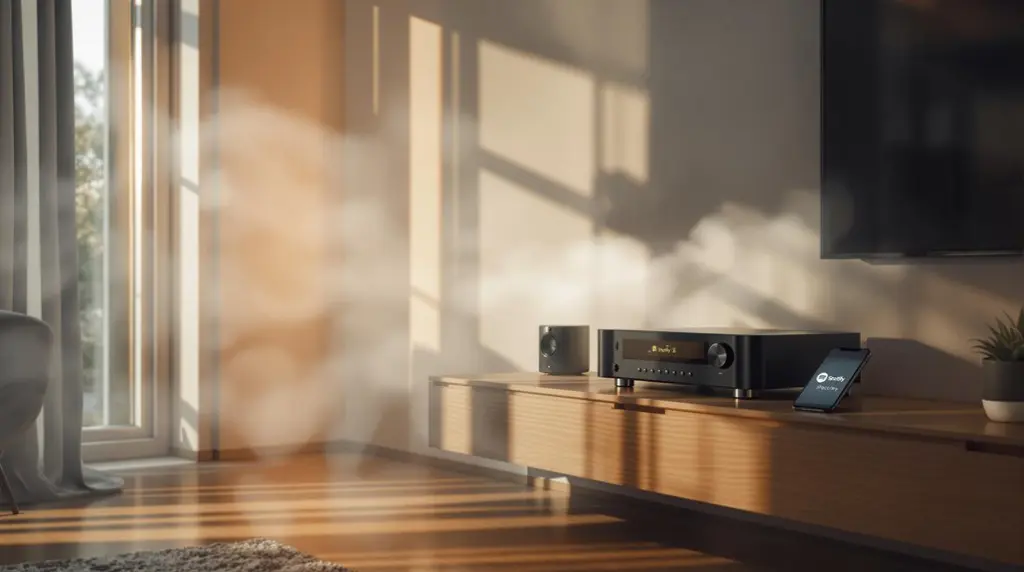Mastering DJ mixing requires a solid grasp of beatmatching and phrasing, proficiency with decks and mixers, and a well-curated music library. Utilize DJ pools like Beatport for high-quality tracks and software such as Serato for seamless BPM detection. Practice setting cue points and manipulating channel faders and EQs for smooth shifts. Incorporate harmonic mixing using the Camelot Wheel for coherent sound blends. Consistent practice is vital to refining techniques and understanding audience dynamics. Engaging with local communities and seeking mentorship can further accelerate skill development. Continue exploring to deepen your expertise in creating unforgettable musical landscapes.
Key Takeaways
- Understand Beatmatching: Align track tempos to ensure seamless transitions and maintain rhythm.
- Curate Your Music Library: Regularly update with high-quality tracks from reputable sources for versatile and engaging sets.
- Master Equipment Usage: Get comfortable with decks, mixers, and software for effective performance and smooth transitions.
- Practice Cueing Techniques: Set precise entry points for tracks to ensure flawless integration into ongoing mixes.
- Learn Harmonic Mixing: Use the Camelot Wheel to blend tracks in compatible keys for a coherent and polished performance.
Understanding DJing
Understanding DJing requires delving into its rich history and evolution, which began with the pioneering radio DJs of the 1930s. Over the decades, DJ history has witnessed significant milestones, such as the establishment of the first commercial club featuring recorded music in 1947.
The genre evolution since then has been driven by cultural influences and advancements in sound technology. Modern DJs navigate a complex interplay of music styles, from house and techno to hip-hop and drum and bass, reflecting a broad spectrum of creative expression. Aspiring DJs should focus on mastering essential skills like beatmatching and phrasing to build a strong foundation.
Mastery of equipment is paramount; proficient DJs treat decks and mixers like instruments, manipulating sound to craft immersive auditory experiences. Performance dynamics hinge on understanding audience interaction, requiring acute awareness of crowd energy and preferences.
Whether in nightclubs or private events, DJs must adeptly read the room to maintain engagement and flow. Live collaboration with musicians introduces additional layers of complexity and spontaneity, enhancing the performance’s dynamism.
Technical expertise in equipment setup and sound balancing guarantees seamless shifts and high-fidelity playback. Ultimately, DJing is an art form that marries technical skill with an intrinsic passion for music, forging connections through shared rhythmic journeys.
Building Your Music Library
A meticulously curated music library is the cornerstone of any successful DJ, serving as the foundation for crafting memorable sets that resonate with audiences. Sourcing high-quality tracks from reputable DJ pools such as Beatport and DJ City is vital. These platforms offer tracks with extended intros and outros, facilitating seamless beatmatching and shifts.
While streaming services can be useful for discovery, owning your music files guarantees accessibility without reliance on internet connectivity, an essential aspect during live performances. Additionally, incorporating unique tracks that define your DJ style can set you apart and create a distinctive sound that audiences will remember.
Understanding song structures—intro, verse, breakdown, and outro—is fundamental for executing smooth shifts and maintaining the flow of a set. This technical knowledge allows DJs to predict and manipulate the progression of tracks, enhancing the overall mixing experience.
Effective library organization is paramount. Categorize your music by genre, energy level, and musical key to expedite track selection and guarantee dynamic, engaging sets.
Regularly updating your library with fresh tracks keeps your sets current and versatile, catering to evolving audience tastes.
Essential DJ Equipment
Selecting the right DJ equipment is vital for delivering professional, high-quality performances. At the core of any DJ setup are decks, whether traditional turntables, CDJs, or all-in-one DJ controllers like the Pioneer DDJ-200 or FLX4, which replicate deck and mixer functionality for beginners.
The choice of DJ software, such as Serato or Rekordbox, is significant in managing your music library and executing precise live performances. Investing in sound quality is non-negotiable. Quality headphones, typically around £100, are indispensable for track monitoring and preparation.
Similarly, studio monitors starting at £150, or professional PA systems, which can cost thousands, guarantee excellent sound clarity and presence. Beginner-friendly controllers often come with bundled software like Serato DJ Lite or Traktor Pro 3, further simplifying the learning process.
Budgeting for equipment is essential. Entry-level setups may begin at £79, but mid-range to professional systems can range from £500 to £6,000 and beyond. This budget should also consider potential gear upgrades, such as advanced audio interfaces for superior sound fidelity and additional connectivity options.
Ultimately, understanding the importance of each component—from controller types to sound quality and the essential role of headphones—will guide your investment decisions, guaranteeing your setup is both functional and scalable for future needs.
Basic DJ Techniques
Having secured the right DJ equipment, the next step involves mastering fundamental techniques that form the backbone of any DJ’s skill set. Track selection is paramount, as the ability to choose the right tracks will dictate the overall flow and energy of the set. Understanding how to blend genres seamlessly can enhance a DJ’s performance, requiring a nuanced approach to tempo, key compatibility, and audience engagement.
Additionally, continuous practice enhances the ability to discern beat discrepancies, essential for mastering beat matching skills.
Cueing is another vital technique. By setting cue points, DJs can guarantee precise entry points for new tracks, facilitating smooth shifts. This process often involves meticulous adjustments to channel gain and EQ settings, allowing for a balanced and harmonious mix. Utilizing headphones for pre-listening is essential, providing an auditory preview before the audience hears the shift.
Mastery of the mixer is indispensable. Proficient use of channel faders, crossfaders, and EQ adjustments will guarantee sound quality and seamless track integration. Moving between tracks demands flexibility in technique; from smooth beatmixing, which blends tracks over multiple musical phrases, to abrupt cuts for immediate impact.
Regular practice is essential. Familiarity with equipment and consistent rehearsal will refine these techniques, enabling DJs to develop a distinctive mixing style and execute flawless shifts during live performances.
Beatmatching Basics
Mastery of beatmatching is the cornerstone of proficient DJing, embodying the precision and artistry that sets skilled DJs apart. Beatmatching entails aligning the tempos of two tracks, ensuring their BPM (beats per minute) are congruent to achieve seamless changes.
Utilizing BPM detection tools embedded in modern DJ software can expedite this process, enabling you to identify and adjust the tempo of tracks with accuracy. Regular practice with a metronome can enhance your timing and synchronization, which is essential for precise beatmatching.
To excel in beatmatching, focus on tempo adjustment and employ phasing techniques to detect and correct any discrepancies. Phasing, the process where two tracks are slightly out of sync, can be identified by a flanging sound. Training your ear to recognize these nuances is vital, which can be honed by practicing with screens covered, thereby relying solely on auditory cues.
Optimal beatmatching occurs when the BPM difference between tracks does not exceed 5, as larger deviations can result in noticeable tempo shifts that disrupt the flow.
Consistent practice in setting precise cue points is also important; they serve as reference markers to facilitate smooth changes and maintain control over your mix. Ultimately, these techniques and diligent practice will raise your mixing prowess.
Cueing Tracks
Cueing tracks, a fundamental skill for any DJ, involves setting a precise starting point within a track to facilitate a flawless shift into the ongoing mix. Mastery of cue point techniques is indispensable for guaranteeing seamless changes that preserve the energy and flow of the set.
When cueing tracks, understanding the structure of songs—such as intros, verses, and choruses—is paramount. This knowledge guarantees accurate placement of cue points, optimizing the flow between tracks. Utilizing headphones is vital; they allow DJs to monitor the cued track, adjust levels, and verify beat matching without disrupting the live mix.
DJ software often provides visual waveforms, aiding in identifying beats and track sections. This visual aid enhances precision in cueing and timing. Regular practice, including sessions where screens are covered, refines auditory skills, enhancing timing and beat-matching proficiency for live performances.
| Cueing Technique | Description | Benefits |
|---|---|---|
| Cue Point Setting | Setting the exact start point | Guarantees precise entry |
| Headphone Usage | Listening to cued track privately | Adjusts levels, beat matching |
| Visual Waveforms | Using software’s beat visuals | Aids in timing accuracy |
| Practice Routines | Regular cueing exercises | Improves auditory skills |
Implementing these advanced techniques will raise your DJ sets, guaranteeing professional-level performance and audience engagement.
Smooth Transitions
Smooth shifts are a cornerstone of professional DJ performance, guaranteeing the seamless blending of tracks to maintain energy and flow on the dance floor. To achieve such smooth changes, one must master several key shift techniques and incorporate dynamic effects. Understanding the impact of tempo on crowd engagement is vital for maintaining the right energy levels. Additionally, utilizing harmonic mixing can make changes more musically pleasing.
- Beatmatching: Align the BPM of two tracks and synchronize their phases. This core skill is essential for maintaining rhythm and preventing abrupt alterations.
- Volume Faders and EQ Adjustments: Smoothly fade in and out of tracks using volume faders, while EQ adjustments can help balance frequencies. This guarantees that neither track overpowers the other during a change.
- Effects: Utilize filters, reverb, and other effects to create dynamic shifts. These effects can mask abrupt alterations and add texture to the mix.
- Cue Points: Set precise cue points to mark specific sections within a track. This allows for quick access and guarantees precise timing during changes.
Experimenting with small BPM variations, typically within a 5 BPM range, can also enhance shifts, keeping them engaging without jarring the audience.
Regular practice with loops and phrasing solidifies these techniques, fostering consistency and confidence in live performances. Mastery of these elements is pivotal for any DJ aiming to deliver a polished, professional set.
Harmonic Mixing
Building upon the foundation of smooth changes, harmonic mixing boosts a DJ’s set by guaranteeing that track alterations not only maintain energy but also enhance musical coherence. This technique involves the strategic blending of tracks in the same key or in key-compatible sequences to create sonically pleasing shifts. The Camelot Wheel, an essential tool in this process, visually represents keys in a circular format, enabling DJs to identify compatible keys effortlessly by moving clockwise or counterclockwise.
Additionally, understanding key relationships can aid in creative and informed track selection, which is vital for delivering a polished performance. Effective mixing strategies using the Camelot Wheel include moving between tracks in the same key (e.g., 8B to 8B) or adjacent keys (e.g., 8B to 7B or 9B). These approaches guarantee seamless harmonic shifts, preserving the musical flow and elevating the audience’s experience.
Key detection software, such as Mixed In Key, further simplifies this process by analyzing a DJ’s music library and providing key information, thereby facilitating quick and efficient track selection. Ultimately, mastering harmonic mixing not only enhances a DJ’s creative scope but also greatly improves audience engagement.
Regular Practice
Consistent practice routines are paramount for DJs aiming to boost their technical prowess and performance quality. By setting concrete track development goals, such as mastering intricate shifts or perfecting beatmatching, DJs can systematically track their progress.
Additionally, utilizing beginner-friendly DJ software like Serato or Traktor can greatly enhance the learning curve. Recording and analyzing practice sessions also provides critical insights into areas needing refinement, fostering continuous improvement and enhanced confidence in live settings.
Consistent Practice Routine
Developing a structured and consistent practice routine is paramount for DJs aiming to refine their technical skills and achieve proficiency. Implementing effective practice strategies and conducting thorough skill assessments are essential components of this process. A regimented approach guarantees that practice time is both productive and progressive, facilitating the mastery of complex DJ techniques.
To optimize your practice routine, consider the following steps:
- Schedule Dedicated Practice Time: Allocate specific hours each week for uninterrupted practice. Consistency, even in short sessions of 30 minutes to an hour, greatly enhances skill development and muscle memory.
- Record and Review Sessions: Regularly record your practice mixes. Reviewing these recordings enables you to identify strengths and pinpoint areas needing improvement, consequently focusing your practice sessions on targeted skill development.
- Set Manageable Goals: Begin with achievable objectives, such as mastering a particular change technique or successfully mixing a set of 5-10 songs. These incremental goals build confidence and competence over time.
- Experiment with Genres: Diversify your practice by experimenting with various genres and mixing styles. This broadens your creative capabilities and adaptability during live performances, making you a more versatile DJ.
Adhering to a consistent practice routine guarantees steady progress, leading to enhanced technical proficiency and artistic growth.
Track Development Goals
Establishing clear track development goals is a fundamental aspect of any proficient DJ’s regular practice routine. Structured goal setting tailored to specific technical skills, such as mastering beat matching or cue point setup, guarantees consistent advancement. Allocating dedicated practice sessions ranging from 30 minutes to several hours per week is essential for honing these skills and building confidence.
A strategic approach to track selection is vital. Curating a playlist of approximately 20 songs within a preferred genre, focusing on tracks with similar BPMs, facilitates seamless shifts and a coherent flow. This method not only enhances technical proficiency but also deepens genre-specific knowledge.
Recording mixes regularly is an invaluable feedback mechanism. Analyzing recordings enables DJs to pinpoint strengths and areas for improvement, fostering a continuous improvement loop. Additionally, setting monthly goals, such as learning a new genre or refining specific mixing techniques, can maintain motivation and track progress effectively.
Incorporating various DJ techniques into practice sessions—such as beat matching, EQ adjustments, and harmonic mixing—promotes a well-rounded skill set. This thorough approach guarantees that DJs are prepared for diverse performance scenarios and can adapt to various musical landscapes with finesse.
Networking and Community
Connecting with the broader DJ community through local groups or online forums can be a cornerstone of career advancement, providing not just camaraderie but access to pivotal networking opportunities and industry insights.
Immersing yourself in collaborative projects is essential; it allows for the exchange of advanced techniques, experiences, and music resources, thereby enriching your personal library and skillset.
Leveraging DJ mentorship from seasoned professionals can offer tailored guidance that accelerates your learning curve. Engaging actively on social media platforms and hosting personal events to build a local following can also play a significant role in enhancing visibility.
Effective networking strategies include:
- Community Events: Attend workshops, seminars, and industry events to gain professional insights and make valuable connections.
- Local Resources: Engage with local DJ communities and participate in competitions or open-mic events to refine your skills and build a local reputation.
- Social Media Engagement: Utilize platforms like Instagram, Facebook, and SoundCloud to expand your reach and connect with other artists and potential fans.
- Collaborative Projects: Partner with other DJs to create unique sets or tracks, facilitating an exchange of knowledge and resources.
Frequently Asked Questions
What to Know as a Beginner DJ?
As a beginner DJ, focus on acquiring essential equipment, mastering beat matching, and utilizing mixing software. Regular practice routines, diverse music selection, and live performance experiences enhance skills. Engage with audiences and explore various genres for thorough growth.
How Do I Improve My DJ Mixing?
To improve your DJ mixing, focus on mastering beatmatching and refining your track selection. Regularly recording your sets for evaluation and experimenting with advanced shift techniques will further enhance your skills, ensuring professional and seamless performances.
How to DJ Step by Step?
To DJ step by step, focus on track selection to curate a cohesive set. Master beatmatching techniques to synchronize tempos seamlessly. Develop proficiency in cueing and changes. Regularly record sets to refine your skills and guarantee continuous improvement.
What Are the Fundamentals of DJ Mixing?
The fundamentals of DJ mixing include mastering beat matching for synchronized shifts, utilizing cue points for precise timing, employing EQ adjustments to balance frequencies, and practicing harmonic mixing for key compatibility, thereby ensuring a seamless and professional performance.
Conclusion
Mastering the art of DJ mixing necessitates a thorough understanding of various fundamental aspects, including music library curation, essential equipment acquisition, and foundational techniques such as beatmatching and harmonic mixing. Regular practice and active participation within the DJ community are paramount for skill enhancement and industry networking. By adhering to these principles and continuously refining techniques, aspiring DJs can achieve proficiency and establish a robust presence within the professional DJing landscape.




